
April A to Z Challenge is Productivity for Creative People.
A to Z Challenge: B is for Backing Up Your Work


 My theme for the April A to Z Challenge is Productivity for Creative People. A to Z Challenge: B is for Backing Up Your Work Backing up your work is mundane but critical. I know friends who have lost countless hours of productive time due to computer malfunctions. You can create your own backups by using a thumb drive or emailing yourself copies of your files. Dropbox offers free backups for up to 2 GB. Backup services like Carbonite are about $60 a year.  If you use Word, the default setting for Autosave is ten minutes (in the latest version). You can change the settings to save more frequently by selecting File, Options, Save, and decreasing the time for “Save Autorecover information every X minutes.” I have mine set to save every four minutes. Do you have a preferred method for backing up your files? Do you have an "I lost my work" story to share?
Welcome to the A to Z Blogging Challenge! My A to Z Theme My A to Z Theme For the next 26 days, I'll be blogging about personal productivity for creative people. Feeling like we don’t have enough time is a common problem, because there never seems to be enough hours to accomplish everything we want in a day, week, year. Think of these blog posts as the best of all the productivity books, articles, and tips that you would read--if only you had more time. The Anti-Muse I’m not a big fan of the “muse” concept. Sure, some days creativity comes easier than others. We’ve all probably experienced flow, where the minutes pass and the creativity continues almost effortlessly. But if we wait for a source of inspiration, it seriously reduces the amount we can create. As William Faulkner said, “I only write when I am inspired. Fortunately, I am inspired at 9 o’clock every morning.”  We can force inspiration by setting up triggers. If we play the same music or light the same candle--whatever trigger works to say IT IS TIME TO CREATE!--the creativity tends to happen. Training the brain to work this way is much more reliable than waiting for a good idea. One writer leaves the laptop on at night for the morning, with email and social media closed, and only the WIP open and ready for the next day. Seth Godin said, “The notion that I do my work here, now, like this, even when I don’t feel like it, and especially when I do not feel like it, is very important. Because lots and lots of people are creative when they feel like it, but you are not going to become a professional if you do it when you don’t feel like it” (from “Honing Your Creative Practice,” Manage Your Day-to-Day). I tend to sit in the same spot, with my laptop and my coffee, when I write on the computer. When I proofread, I sit at a desk and use a purple pen to mark my manuscript. These changes help me adjust to the change in work mode. In his article, How to Be Motivated Every Day, James Clear says, "Most people never get moving because they can’t decide how to get started. Having a ritual takes that burden off your shoulders." Do you have any triggers for creativity or something that helps put you in a creative flow?
 Feeling like we don’t have enough time is a common problem. There never seems to be enough hours to accomplish everything we want in a day, week, year. For 26 days in April, I’ll be blogging about personal productivity, especially as it relates to creative people. My goal is to provide ideas, techniques, and inspiration for increasing your personal productivity. The A to Z challenge starts on April 1. 2016 A to Z Theme: Productivity for Creative PeopleI also blogged about productivity in the 2015 challenge. My previous posts are listed below. (Obviously, 2016 will feature new material!) 2015 A to Z: Posts about ProductivityA is for Analyze: How Do You Spend Your Time? B is for Beginning: Wisdom from Newton, Hemingway, and Others about the Power of Getting Started C is for Ciotti: Interview with Sparring Mind's Gregory Ciotti D is for Digital Procrastination and the Illusion of Productivity E is for Exercise F is for Focus and Flow G is for Getting Things Done H is for How to Procrastinate I is for Important Things First: Prioritizing Tasks J is for Julie: A Calendar Trick from Author Julie Lindsey K is for Killing Time: An Unscientific List of the Best 5 Ways L is for Lifehacks and Links M is for Myths about Productivity N is for "No" O is for Open Loops (Unfinished Business) P is for Pomodoro Technique Q is for Quit Bad Habits R is for Routines and Rituals S is for Sleep T is for Technology Tools U is for Unclutter: The Life-Changing Magic of Tidying Up V is for Vanderkam: Interview with Productivity Author Laura Vanderkam W is for Will Power (Which Isn't Enough) X is for Xeriscape Y is for Yours Truly: Productivity Advice from Yvonne Z is for Zig Ziglar Quote If you're participating in A to Z, include your theme below.
If not, do you have a favorite topic you like to read about on blogs? Did you know that "80% of YA novels are now purchased by adults, with the vast majority of those purchases being for the adults themselves"? What Can Data Tell Us?: An Agent's Thoughts on the 2015 Nielsen Children's Book Summit by Stephen Barbara is an interesting look at publishing data and its implications.  Blogging friends: Sign-ups for the A to Z Blogging Challenge are now open! Last year, I blogged about Productivity for Creative People from A to Z. I collected these posts on Pinterest or you can access them through this Reflection post about last year's challenge. I plan on participating again this year. Are you an adult you reads YA? (I am!)
Will you be participating in the A to Z Blogging Challenge? Happy New Year! A new year often brings new resolutions. I thought about what advice I could give on this topic, and since many of my resolutions are repeats from last year, I decided I'm not a qualified expert on this. What I can do, however, is provide you with 5 interesting links to start off 2016.  If you want to achieve more (who doesn't?), here's some inspirational and practical advice from James Clear: The Only Productivity Tip You'll Ever Need.  If your goal is organize, check out this list for some innovative ideas: 52 Meticulous Organizing Tips To Rein In The Chaos.  If you're a writer, you might be interested in Jane Friedman's 5 Industry Issues to Watch in 2016 and Betsy Bird's SLJ article, What’s Trending? What Is, What Was, What’s Soon to Be in Kid Lit.  Also for writers: Heather Ayris Burnell has compiled a lengthy list of contests you can enter on the Sub It Club blog.  Lastly, if you use Twitter, check out their plans to expand from 140-characters in this Wall St. Journal article. (Say it isn't so, Twitter!) Do you have resolutions for the upcoming year? Or maybe anti-resolutions? Share your own favorite related links or advice in the comments.
Some good news! My next young adult novel, coming out in Fall 2016 from Sky Pony Press, has a new title: BLACK FLOWERS, WHITE LIES. If you'd like to keep up with this kind of information, please consider subscribing to my newsletter. And now, on to the Friday Five: Five Tips for Staying Organized While Marketing a Book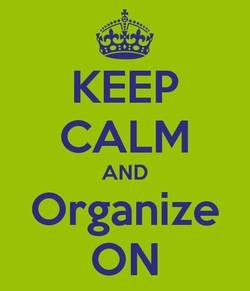 Promoting a new novel can be a whirlwind of activity. Here are five ideas for staying organized during the madness that is book marketing. 1. Publicity opportunities require the same information over and over again, so create a Word file with all of your frequently used links: your website, social media links, and book sale sites. Keep a version of your bio in the file, too, so you can easily cut and paste. I keep the file in the same folder as a copy of my book cover jpg and my author photo, that way the info is simple to access. 2. Keep track of interviews you’ve done. You can print them in a folder or bookmark them online, or even create a list of links on your website “media” page. But at some point when you’ve done quite a few, it’s helpful to have a way to remember who you’ve spoken to and what you’ve said. You can also consider making a table. Here’s a sample from mine: 3. Create an event “go” bag and keep it stocked with supplies for library panels, book festivals, etc. Include a display copy of your book, bookplates, favorite signing pens, bookmarks, and business cards. Consider bringing an envelope of small bills if you ever handle your own sales and need to make change. I also have a laminated “author signing today” poster of Pandemic’s book cover, an inexpensive washable white tablecloth, scissors, and tape in my bag. (If you drive to an event that will provide copies of your book, it’s still a good idea to bring extra books with you just in case. I’ve been to many events where there were “glitches” with getting an author’s books in stock.) 4. Sometimes a book festival (or other event) is just too far or maybe the date doesn’t work. Time passes and when people start buzzing about said event on social media, I may forget why I chose not to participate. To avoid these lapses in memory, I developed the “Not Doing” folder where I keep information on events I’ve decided to forego with a note about why. 5. Besides your regular to do list, keep a Kindness list. I jot down all the nice, helpful, kind things people have done for me during the process of launching and marketing Pandemic. An acquaintance writes a glowing review, an old friend travels to my book launch, another writer lets me know about an upcoming festival. During a process where so much is out of my control, keeping a kindness list helps me focus on the positive. Please share any of your own writing/marketing organizational tips in the comments. This will be my last post for 2015, but I look forward to more blogging in the new year.
Productivity is an interesting concept, especially for creative people, because our “work” for each day isn’t always clearly defined. Without specific deadlines, we can sit around waiting for the muse instead of plowing ahead. Consistent progress can sometimes be a struggle. Here are a few thoughts on staying motivated, after you've recovered from Thanksgiving: 1. If you don’t have an external deadline, create one. For example, pick a date to exchange manuscripts with a critique partner or promise to have the story ready for beta readers by a certain time. Making a commitment that involves other people can work wonders for motivation. 2. Create a chain, as Jerry Seinfeld once advised a new comedian. Using a calendar, make a large X each day you complete a certain task. Soon the line of Xs becomes self-perpetuating because you don’t want to break the streak. (FYI -- gold stars work, too!) James Clear says on Entrepreneur.com, “The Seinfeld Strategy works because it helps to take the focus off of each individual performance and puts the emphasis on the process instead. It's not about how you feel, how inspired you are, or how brilliant your work is that day. Instead, it's just about ‘not breaking the chain.’” If you are looking for online support, the Monthly Twitter Writing Challenge encourages participant to write or revise daily for the month and document it on the group spreadsheet, mixing the “Seinfeld Strategy” with public commitment--a winning combination! The same can be said for NaNoWriMo. 3. Make a plan that divides “writing a novel” (a huge, scary project) into manageable pieces. Set goals to write the first chapter, decide character names, write the second chapter, research the setting, etc. If you want to finish a novel in a certain time period, approximately how many words do you need to write a month? Make a schedule. It can always be adjusted, of course, but, as Antoine de Saint-Exupéry said, “A goal without a plan is just a wish.” I usually blog with a "five" theme on Friday, but the holiday weekend merits a shorter post. If you want to read more of my thoughts about this topic, you can read a collection of my productivity posts from A to Z. If you have any favorite tips or resources, please share!
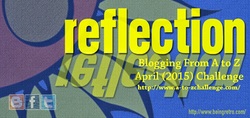 Part of the A to Z Blogging Challenge tradition is to write a “reflection” about the April experience. Participants can post a reflection on their blogs any time this week. Reflection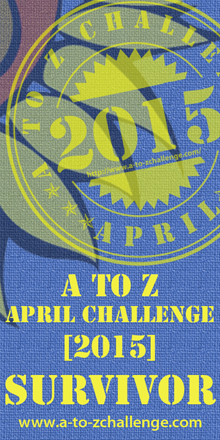 Having survived last year’s challenge, this year I wrote all my posts ahead of time. What I lost in flexibility, I gained in peace of mind and preparedness. I don’t think I would have finished otherwise. One of the nicest parts of the challenge is visiting other blogs and corresponding with other bloggers. I tried to be more organized this year in my approach to this, but I still didn’t have enough time to visit as many blogs as I wanted. One thing I wished for: after the theme reveal, I would have liked a list of participating blogs along with their themes. Seeing the themes upfront would help me choose some of the other blogs to visit. I helped with A to Z this year by being a minion on C. Lee McKenzie’s “Muffin Commando Squad.” It made me appreciate how much effort goes into running the A to Z Challenge, but it also added to the time I spent on A to Z this month. (A shout-out to my fellow muffins Carrie Butler, Patricia Lynne, Tyrean Martinson, Donna McDine, Tammy Theriault and Tara Tyler.) I really enjoyed researching and writing about my productivity theme. If you’d like to read my A to Z productivity-themed blog posts, here they are. (I also gathered them on a Pinterest board.)
A is for Analyze: How Do You Spend Your Time? B is for Beginning: Wisdom from Newton, Hemingway, and Others about the Power of Getting Started C is for Ciotti: Interview with Sparring Mind's Gregory Ciotti D is for Digital Procrastination and the Illusion of Productivity E is for Exercise F is for Focus and Flow G is for Getting Things Done H is for How to Procrastinate I is for Important Things First: Prioritizing Tasks J is for Julie: A Calendar Trick from Author Julie Lindsey K is for Killing Time: An Unscientific List of the Best 5 Ways L is for Lifehacks and Links M is for Myths about Productivity N is for "No" O is for Open Loops (Unfinished Business) P is for Pomodoro Technique Q is for Quit Bad Habits R is for Routines and Rituals S is for Sleep T is for Technology Tools U is for Unclutter: The Life-Changing Magic of Tidying Up V is for Vanderkam: Interview with Productivity Author Laura Vanderkam W is for Will Power (Which Isn't Enough) X is for Xeriscape Y is for Yours Truly: Productivity Advice from Yvonne Z is for Zig Ziglar Quote What were the best parts of the challenge for you? Will you participate in the challenge next year? Share a link to your own reflections in the comments if you’d like. 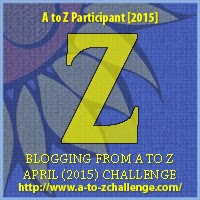 Hooray for Z! I've enjoyed providing this alphabetical guide of productivity strategies and techniques. I hope you found the blog posts helpful. I'm creating a Pinterest board of all the A to Z posts here. In case you missed my W is for Will Power post, be sure to read about another Z idea, the Zeigarnik Effect. In May, I will (slowly) get back to my regular schedule, blogging for teen writers on Teen Tuesday and writers of all ages with the Friday Five. I'll end this challenge with a quote from "Zig" Ziglar (Hilary Hinton Ziglar), a motivational speaker: I love motivational quotes. Please share your own favorites in the comments.
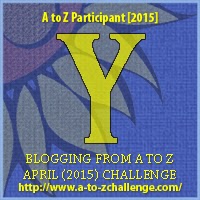 I've really enjoyed reading books, researching articles, and interviewing experts for these productivity-themed blog posts. Since the end of the alphabet is near, I'd like to share a few bits of my own advice. Keep an accomplishments list.To-do lists keep track of what needs to get done. But to balance that, it's helpful to keep a list of major items that have been completed. For example, when my novel was about to launch, the days were filled with activity, yet at the end of the week I couldn't always remember what I was so busy doing. I started tracking my accomplishments each month and the habit stuck. Over time, these monthly lists can be a boost to morale--look at everything that is getting taken care of! Group difficult tasks together. Reduce grumpiness! Reduce grumpiness! One thing I dread doing is calling or emailing people to ask for interviews. I have to psyche myself up to do this. If I have three requests to make, I could do one a day for three different days, or I can group them together and just "ruin" one morning. This is a very specific example, but I think you can see what I mean. If certain tasks make you grumpy, group them together and do them all at one time. Then you can be cheerfully efficient the rest of the week. Keep a kindness list.So many people have done kind things for me during my writing and publication journey that I decided to jot them down. It's a simple list with a name and a few words that remind me of the niceness in the world. An author takes the time to blurb my book. A teen reader emails me about how much he enjoyed Pandemic. A friend tells me about an upcoming book festival I can apply to. Is there a scientific link to productivity and tracking these kindnesses? I have no idea. But it creates happiness and that has to be a good thing! Do you have any favorite or unique approaches to productivity?
|
JOIN NOW!
Sign up for Yvonne's newsletter for exclusive content, book news, and other occasional author goodies. Archives
June 2025
Categories
All
|